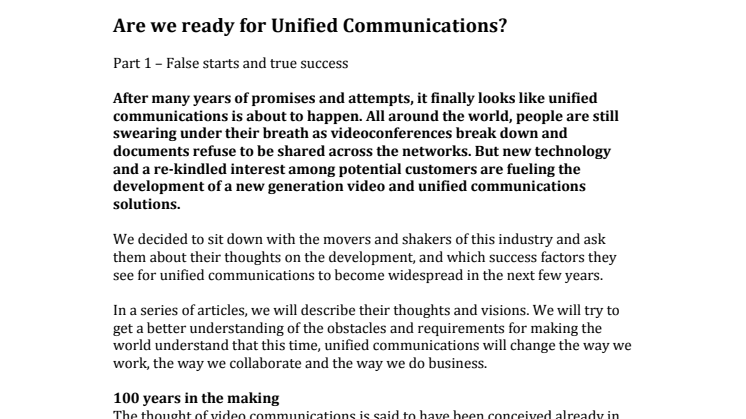News -
Are we ready for Unified Communications?
Part 1 – False starts and true success
After many years of promises and attempts, it finally looks like unified communications is about to happen. All around the world, people are still swearing under their breath as videoconferences break down and documents refuse to be shared across the networks. But new technology and a re-kindled interest among potential customers are fueling the development of a new generation video and unified communications solutions.
We decided to sit down with the movers and shakers of this industry and ask them about their thoughts on the development, and which success factors they see for unified communications to become widespread in the next few years.
In a series of articles, we will describe their thoughts and visions. We will try to get a better understanding of the obstacles and requirements for making the world understand that this time, unified communications will change the way we work, the way we collaborate and the way we do business.
100 years in the making
The thought of video communications is said to have been conceived already in the 1920s. Even though the years leading up to the 1980s saw several analog attempts, it was with the ISDN based systems from companies like AT&T and Tandberg that the technology become truly useful and reasonably affordable for companies.
Most futuristic visions from a few decades back include video communications. But 20 years later, the vast majority of calls are still done with voice only. There are many reasons and possible explanations. The technology wasn’t ready, the lack of industry standards meant that different systems couldn’t talk to each other. Instead of one industry standard, every company developed their own.
Complex, expensive and proprietary
Also, even as some standard protocols started gaining acceptance, like VT-100, most terminals came with a price tag that would scare away even the most avid video proponents. Anyone who saw a serious telepresence demo realized the potential. But investments in the range of 10s or 100s of thousands of dollars for an installation made it difficult to motivate initially.
For those without the means to implement these solutions, companies like Citrix and Cisco developed their own platforms using their own protocols to allow for people to connect and share their information over standard corporate infrastructure and Internet connections.
Video to the people
But it was companies like Skype and later Apple that brought integrated video communications to the people. They showed the general public just how easy and powerful video could be.
Unfortunately, this type of communications over public Internet and connections without any bandwidth control, encryption issues and lack of management functionality can sometimes result in poor performance and low quality in both image and sound - despite using a fast Internet connection.
But in the last few years, the long-promised unified communications is finally starting to take shape. With solutions like Microsoft Lync and Google Enterprise, the visual communications and sharing is being built into the core solutions and brought all the way out to the users. But many components must deliver - on their own and together.
It all comes down to this; is the industry ready to demonstrate the true power of the unified communications? Please discuss on #futureucPhoto credit: Rama, licence Cc-by-sa-2.0.fr
Topics
- Data, Telecom, IT
Categories
- unified communications
- #futureuc

